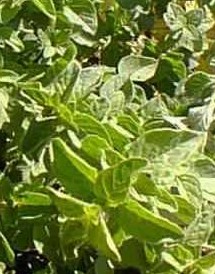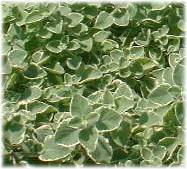 Mentioning
Oregano immediately brings to mind tomato sauces and Italian cooking. Oregano
is part of a fairly large genus of herbs, and there are many similar plants
in this genus that are mistakenly identified as Oregano. A notable
one is Marjoram.
Oreganos are aromatic
perennial
plants with hairy square stems, and have a hot, peppery taste. Although
we think of it mostly as being an addition to pizza and spaghetti, Oregano
actually mingles well with a large number of foods, including roasted and
stewed beef, poultry, game, marinated vegetables, potatoes, cheese and egg
combinations, onions, shellfish, and roasted bell peppers.
Mentioning
Oregano immediately brings to mind tomato sauces and Italian cooking. Oregano
is part of a fairly large genus of herbs, and there are many similar plants
in this genus that are mistakenly identified as Oregano. A notable
one is Marjoram.
Oreganos are aromatic
perennial
plants with hairy square stems, and have a hot, peppery taste. Although
we think of it mostly as being an addition to pizza and spaghetti, Oregano
actually mingles well with a large number of foods, including roasted and
stewed beef, poultry, game, marinated vegetables, potatoes, cheese and egg
combinations, onions, shellfish, and roasted bell peppers.
Oregano can be used fresh or dried. It prefers well drained, average
soil and full sun. It is native to the Mediterranean all the way to
central Asia, but has naturalized widely in North America. It has
tubular rose-purple to white flowers and blooms June to September. Plants
themselves can be upright or mounding with underground rhizomes, with a
maximum height for the uprights of 2-3 feet. Regular cuttings promote
bushy growth on all oreganos.

Cuban Oregano
Cuban Oregano is a member of
the same family as Coleus, and as such is not a true oregano. It does
share the same general taste as the oreganos, and can be used as a substitute,
though this is more common in Cuba and surrounding areas than it is in the
US. Cuban Oregano makes a nice houseplant - especially the variegated
type shown above, and is propagated easily by cuttings.
 Mentioning
Oregano immediately brings to mind tomato sauces and Italian cooking. Oregano
is part of a fairly large genus of herbs, and there are many similar plants
in this genus that are mistakenly identified as Oregano. A notable
one is
Mentioning
Oregano immediately brings to mind tomato sauces and Italian cooking. Oregano
is part of a fairly large genus of herbs, and there are many similar plants
in this genus that are mistakenly identified as Oregano. A notable
one is 